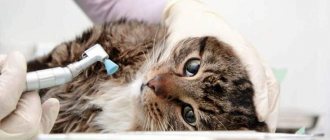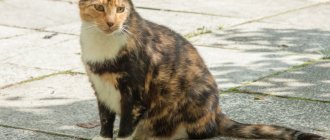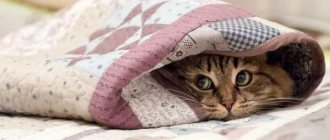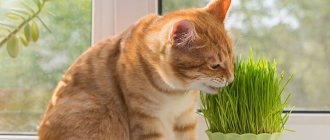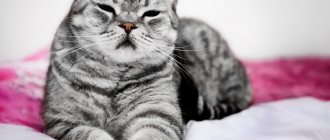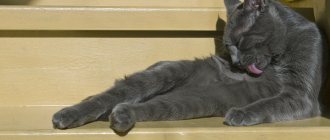If your beloved cat shows an increased interest in indoor plants and perceives flowers not only as home decoration, then there are some ways in which you can discourage your cat from such a bad habit as eating flowers. Moreover, the cat can not only gnaw on indoor plants, but also sleep on them and even go to the toilet in a cute pot. You can wean your cat off this bad habit only gradually, so you should have the necessary patience.
Why do cats eat plants and greens?
Cats are predators by nature. The basis of their diet is meat products. In their natural environment, cats feed on small rodents and birds. Since animals eat their prey whole, along with hair and bones, undigested food debris accumulates in the gastrointestinal tract, which is not subject to the action of digestive enzymes. Therefore, cats eat grass and plants to cleanse the digestive tract . The blades of grass irritate the gastric mucosa, provoking a gag reflex.
In addition, cats constantly lick and groom their fur. “Wool” lumps accumulate in the stomach. And to cleanse themselves of this “ballast”, cats also resort to the help of plants. This is a natural physiological process and since animals, unlike humans, cannot control and suppress the instincts inherent in nature, they show interest in decorative indoor flowers.
Some plants, herbs, greens, which cats are partial to, not only cleanse the stomach and intestines of undigested food particles and hairballs, but also help normalize digestion, eliminate constipation, neutralize toxins if the animal is poisoned, and also saturate the body with useful substances.
Each cat has its own preferences regarding plants. Some pets love sprouted oats, others happily gnaw on soft violet leaves and eat hibiscus and anthurium flowers. As a rule, cats most like to gnaw on flowers that resemble grass (dracaenas, chlorophytums, narrow-leaved palms). In addition, small kittens and even adult pets use the leaves that hang down as toys.
If a domestic cat likes to dig in flowers and happily eats leaves of indoor plants, this may be due to the following reasons:
- hypovitaminosis;
- banal harmfulness;
- boredom, lack of attention;
- metabolic disorders;
- invasive diseases (helminthiasis);
- poisoning;
- constipation;
- perverted appetite (parorexia);
- compulsive disorders;
- accumulation of a large amount of wool in the stomach;
- disruption of digestive processes.
Important! If a cat happily gnaws on the greens of house plants, it may not be receiving enough nutrients, vitamins, and amino acids from the food, which can cause hypovitaminosis.
Sometimes cats start nibbling flowers, digging in flower pots, or defecating in flowerpots out of spite. Thus, furry pets try to attract attention to themselves. The pet may not be comfortable with its litter tray or its location in the house or apartment.
Small kittens tend to damage flowerpots out of curiosity. By testing plants by their teeth, they study the world around them. In addition, kids are incredibly curious, playful and inquisitive. Therefore, indoor flowers, especially hanging plants and vines, can attract them in the form of toys.
Alternative Methods
If your cat chews or eats flowers due to a lack of vitamins and nutrients, adjust the diet. If your pet is kept on a natural diet, supplement the diet with vegetables and multivitamin complexes. When feeding prepared foods, choose products marked “permium” or “extra” class. Introduce vegetables and green food into your pet's diet. Some cats happily eat cabbage leaves, tomatoes, zucchini, watermelon, cucumbers, and berries.
To prevent your cat from spoiling your home flowers, plant healthy plants (sprouted oats, wheat, cereals, catnip) in flower containers to cleanse the stomach of fur. Pet stores have special herbs for animals that are more attractive to animals than indoor flowers.
You can give your cat dandelion leaves, young nettles after scalding them with boiling water, spinach, plantain, and leeks.
Important! Before giving your pet herbs brought from outside, rinse them well under running water, as they may contain helminth eggs, viruses, and bacteria.
To avoid causing stomach upset, give your cat only dry plants. Buy food or special additives that help remove hair from the cat’s gastrointestinal tract. Distract your cat's attention from plants with toys and interesting active games. When leaving home, leave your pet a variety of interactive toys that will brighten up your pet’s leisure time while no one is home.
You can stop a cat from eating indoor flowers only with the right approach and attentive attitude. Show persistence and consistency in your actions.
Other reasons
It also happens that cats eat decorative flowers due to obsessive-compulsive disorders. If a pet is obsessed with chewing, constantly chews something, drags it into its mouth, sucks on various objects (cotton, fabrics, cotton wool, rags, soft toys) - this indicates that the animal suffers from obsessive-compulsive disorder . As a rule, a similar condition is noted in Burmese, Abyssinian, Siamese, and exotic cats. Unfortunately, it is not always possible to stop this behavior, so if you encounter a similar problem, contact a veterinary specialist (veterinary behaviorist).
If a cat constantly eats inedible objects with pleasure, chews electrical cords, walls, paper, wallpaper, ropes, and the ground, and at the same time does this constantly and with great pleasure, most likely the pet suffers from parorexia (perverted appetite).
This phenomenon can be caused by severe stress, emotional tension, genetic predisposition, congenital anomalies, but you need to understand that such behavior is very dangerous for the health and life of the cat. Foreign objects can clog the intestinal lumen, damage the mucous membrane of the gastrointestinal tract, causing acute inflammation, and cause poisoning and intoxication.
If your pet suffers from parorexia, we recommend reducing the number of indoor flowers in the house or removing them altogether.
Why you need to stop your cat from eating indoor flowers
Some ornamental green plants are very poisonous to cats. Geranium, galanthus, cala, spatephyllum, asparagus, cyclamen, ivy, ficus, some types of dracaena are unsafe for furry pets. Pollen from tulips, hyacinths, daffodils, and other flowers causes severe allergies in cats. Hydrangea provokes acute indigestion, vomiting, abdominal cramps, and helleborus disrupts the heart rhythm.
Despite the fact that cats are very selective in food, a small kitten, due to inexperience, having tasted a poisonous plant, can become seriously poisoned.
No less dangerous for animals are the products used to control pests of indoor flowers, as well as fertilizers for foliar feeding.
Some plant species are deadly to animals. In addition to intoxication, substances contained in poisonous flowers inhibit the functioning of the cardiovascular system and respiratory center, provoke muscle spasms, paralysis of muscle structures, and anaphylactic shock.
Many types of ficus cause burns to the mucous membrane of the stomach, oral cavity, and larynx, provoke acute inflammation in the digestive tract, and lead to damage to the liver and kidneys.
Therefore, if you have a cat at home, consult with your veterinarian which indoor plants pose a danger to pets.
What problems can cats have when they eat flowers?
Unfortunately, cats do not quite understand how poisonous this or that plant they eat is:
- For example, geranium can cause gastrointestinal upset; as a rule, in this case the pet’s digestion suffers.
- Eating ficus not only leads to a burn to the gastric mucosa, but can also cause kidney damage.
- Eating chrysanthemums can cause an allergic reaction, leading to cramps and vomiting.
As we have seen, there are many methods to help keep your tailed pet away from your home plant. Moreover, it is necessary not to allow them to eat plants only with the best intentions. And to satisfy natural instincts, it is necessary to include in the pet’s food the necessary vitamins and tasty grass, which will be much tastier and healthier to chew than window geranium.
We recommend reading: Why is it necessary to have grass in the diet for cats and how to grow it?
What to do if a cat spoils house plants
It is necessary to instill in a cat the correct manners of behavior from an early age gradually but persistently. The cat must understand what he is allowed to do and what he is not allowed to do.
When weaning your pet from bad habits, including eating indoor flowers, never resort to physical violence, rudeness, or screaming. This approach will only aggravate the situation and will not achieve the desired result.
Cats not only do not understand rudeness, but they can also do things to spite you in the future, and at the same time they will play pranks in your absence. Raising animals requires consistency, patience, and perseverance.
Advice! Unlike dogs, raising a cat is much more difficult with prohibitions and punishments. It is much easier to “agree” with a cat or outsmart him.
To wean your cat from eating indoor plants, digging up soil in flowerpots, turning over flower pots, you need to make flowers unattractive to your pet or block access to flowers.
Place plants that your pet is particularly interested in out of the reach of your cat. Buy special stands for flowerpots and hanging flowerpots. Place pots of flowers on cabinets, under the ceiling. Of course, in this case, it is possible that the cat will not be able to get to the flowers. The forbidden fruit is sweet and cats are very inventive animals, so the pet will try to get to the flowers through curtains, carpets, and furniture. But still, try to create the safest possible environment for your pet.
To wean your cat off from eating flowers, lubricate the leaves, flowers, and trunks of plants with lemon juice, hot pepper, and other non-toxic products that have a pungent odor and unpleasant bitter taste. The leaves can be treated with garlic water. Having tasted a treated “inedible” plant, the animal will lose interest in the flower. Near the flowers, place peels and slices of citrus fruits, the smell of which cats cannot stand.
To discourage a cat from climbing into flower pots, place bowls with essential oils or repellent sensors on the windowsills that react to movement and produce a sound that is unpleasant for cats. There are also special “repellents” for cats in aerosols and sprays that can be used to spray flower pots.
Important! When processing plants, use only products that are safe for animals and plant flora. It is strictly forbidden to use medications, chemicals, or toxic substances.
If a cat approaches a flowerpot, scare the pet with a sharp sound, clap your hands, and spray the pet with water from a spray bottle. The effect of surprise works very well on cats. Frightened, the cat will associate flowers with something “scary” and unpleasant.
If a cat has gotten into the habit of relieving itself in flowerpots, it will not be easy to wean him off this habit. The smell of feces will constantly attract your pet, so completely change the soil in the flower and transplant the plant into another pot. To prevent the cat from going to the toilet in flowers in the future, or digging the soil in flowerpots, add a layer of gravel, small pebbles, and shells on top of the soil. You can use sprays with cat repellent scents.
Psychological methods to help protect flowers from being eaten
You can try to explain to the cat that you can’t touch the flowers growing in the house. If they don’t understand, then you can use pet scaring:
- For these purposes, you need to buy a water pistol and, as soon as you notice that the cat is heading towards the flowers, you need to spray a small stream of water at it. Gradually, the image that flowers are wet and cold will enter her consciousness, and she will forget the way to them. This procedure should only be carried out when cat grass is planted. Moreover, scaring is used only from those flowers that do not grow for animals to eat. This technique requires a lot of time, dexterity and observation of the owner.
- In the process of raising a kitten, you need to be firm and not give any slack to these cute creatures. As soon as he starts moving towards plants, you need to scold him. Moreover, this must be done constantly; eventually, the pet will understand its unwanted behavior.
- You can use store-bought cat bleach. It is placed in close proximity to flowers and reacts to the slightest movement of the animal. As soon as the cat is near the indoor plant, it begins its action. Depending on the type of action, they can emit an odor that is unpleasant to the pet, a water jet, a loud sound, such as a siren, or ultrasonic waves. This method is quite effective in preventing your pet from eating flowers.
